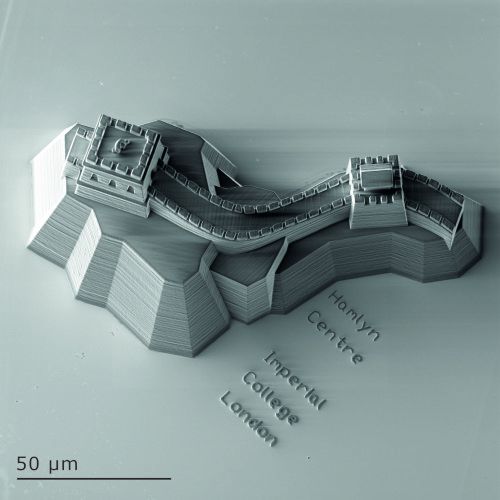Tag archives: 3D printing
3D cosmic-microwave background, iPhone paper and Dance Your PhD winner
By Michael Banks
It might look like a kind of dumpling at first sight, but upon closer inspection the eagle eyed might spot that it is actually a 3D version of the cosmic microwave background (CMB) – the thermal remnant of the Big Bang that came into being when the universe was only 380 000 years old. The model was created by physicist Dave Clements from Imperial College London who says that detailed maps of the CMB – created by space telescopes such as the European Space Agency’s Planck satellite – are difficult to view in 2D. (more…)
View all posts by this author | View this author's profile
Rosetta and bedbugs, LIGO and dark matter, arXiving science and more…
By Tushna Commissariat
Space missions and insects are not the most usual of bedfellows. But in a wonderful example of how space technology can be translated into practical devices for use here on Earth, a UK company has repurposed and adapted an analyser used onboard the Rosetta mission – that in 2014 landed a probe on a comet for the first time – to sniff out bedbugs. The pest-control company, Insect Research Systems, has created a 3D-printed detector that picks up bodily gas emissions from bedbugs – such a device could be of particular use in the hotel industry, for example, where many rooms need to be quickly scanned. The device is based on the Ptolemy analyser on the Philae lander, which was designed to use mass spectroscopy to study the comet’s surface.
“Thanks to the latest 3D-printing capabilities, excellent design input and technical support available at the Campus Technology Hub, we have been able to optimize the design of our prototype and now have a product that we can demonstrate to future investors,” says Taff Morgan, Insect Research Systems chief technical officer, who was one of the main scientists on Ptolemy. In the TEDx video above, he talks about the many technological spin-offs that came from Ptolemy – skip ahead to 13:45 if you only want to hear about the bedbugs, though.
Tiny gifts for world leaders, Hubble’s birthday and more

Tiny trophy: The Great Wall of China, printed with a Nanoscribe system at the Hamlyn Centre, Imperial College London. (Courtesy: Nanoscribe)
By Hamish Johnston and Tushna Commissariat
Last month, China’s president Xi Jinping’s was on a state visit in the UK and while here, he toured a few academic institutions, including the UK’s new National Graphene Institute (NGI) in Manchester and Imperial College London. As we reported in an earlier blog, Nobel-prize-winning Manchester physicist Kostya Novoselov presented President Xi “with a gift of traditional Chinese-style artwork, which Kostya himself had painted using graphene paint”. This week we found out that the Imperial scientists also presented him with a “tiny gift” in the form of a 50 µm scale version of a section of the Great Wall of China, imaged above, created with a Nanoscribe 3D printer. Prince Andrew, who was also on the visit, was given an image of a panda leaping over a bamboo cane, which was printed on the tip of a needle.
Converging streams, secret science and more
By Tushna Commissariat
Regular readers will know that Physics World‘s Hamish Johnston and Louise Mayor will be attending the “Convergence” conference at the Perimeter Institute in Canada from tomorrow onwards. While the conference will undoubtedly prove exciting – just look at this list of speakers – it looks like the institute already has convergence on its mind as this month’s Slice of PI contemplates the “converging streams” of art and science. The video above features Perimeter researcher and artist Alioscia Hamma, who finds solace and symmetry in both his art and physics. Watch the video and read more about his work on the Perimeter blog.
View all posts by this author | View this author's profile
3D printing, Ada Lovelace and controversial bloggers
By James Dacey
One of the more inspiring stories we have come across this week was the tale of a resourceful inventor in the West African nation of Togo. Kodjo Afate Gnikou has managed to build a 3D printer at the meagre cost of $100 by mainly using parts he found in a scrap yard in the capital city Lomé. The story is described on inhabitat.com, which says the machine has been constructed from broken scanners, computers, printers and other e-waste.
On the subject of 3D printing, Wired magazine ran a story about how the UK supermarket chain Asda is planning to trial a 3D printing service at its store in York. They will be offering customers the chance to take a break from their shopping to have a full body scan, which will be used to create miniature dolls of themselves. Prices apparently start at £40 and Asda boasts about how lifelike these dolls can be: “The technology produces highly realistic ‘mini me’ figurines at whatever scale you like!”

Portrait of Ada Lovelace (1838)
From a shop in York to the next story that involved celebrations all round the world. Tuesday was Ada Lovelace Day 2013. The annual celebrations, which are now in their fifth year, are held to recognize the achievements of women in science, technology, engineering and maths (STEM). The annual event was founded in 2009 by the social technologist and writer Suw Charman-Anderson “as a response to online discussions about the lack of women on stage at tech conferences”.
This year events included a mass Wikipedia “editathon” at the University of Oxford in an attempt to raise the profile of women’s contributions to science, as described in this article in the Guardian.
View all posts by this author | View this author's profile